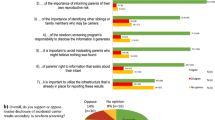Abstract
Despite the increase in the number of inherited metabolic diseases that can be detected at birth using a single dried blood spot sample, the impact of false positive results on parents remains a concern. We used an economic approach - the contingent valuation method – which asks parents to give their maximum willingness to pay for an extension in a screening programme and the degree to which the potential for false positive results diminishes their valuations. 160 parents of a child or children under the age of 16 years were surveyed and given descriptions of the current screening programme in the UK, an extended programme and an extended programme with no false positives. 148 (92.5%) respondents said they would accept the screen for the five extra conditions in an expanded screening programme whilst 10 (6.3%) said they would not and two were unsure. When asked to indicate if they would choose to be screened under an expanded screening programme with no false positive results, 152 (95%) said they would, five (3.1%) said they would not, two were unsure, and there was one non-response. 151 (94.4%) said they preferred the hypothetical test with no false-positives. The mean willingness to pay for the expanded programme was £178 compared to £219 for the hypothetical expanded programme without false positives (p > 0.05). The results suggest that there is widespread parental support for extended screening in the UK and that the number of false-positives is a relatively small issue.
Similar content being viewed by others
References
Arrow K et al (1993) Report of the NOAA Panel on Contingent Valuation. Fed Regist 58(10):4601–4614
Bodamer OA, Hoffmann GF, Lindner M (2007) Expanded screening in Europe 2007. J Inherit Metab Dis 30:439–444
Cookson R (2003) Willingness to pay methods in health care: a sceptical view. Health Econ 12:891–894
Dixon S, Shackley P (2003) The use of willingness to pay to assess public preferences towards the fortification of foodstuffs with folic acid. Health Expect 6:140–148
Gold M, Siegel J, Russell L, Weinstein M (1996) Cost-effectiveness in health and medicine. Oxford University Press, New York
Hewlett J, Waisbren SE (2006) A review of the psychosocial effects of false-positive results on parents and current communication practices in newborn screening. J Inherit Metab Dis 29:677–682
Kai J, Ulph F, Cullinan T, Qureshi N (2009) Communication of carrier status information following universal newborn screening for sickle cell disorders and cystic fibrosis: qualitative study of experience and practice. Health Technol Assess 13(57):1–82
Lloyd A (2003) Threats to the estimation of benefit: are preferences elicitation methods accurate. Health Econ 12:393–402
National Institute for Health and Clinical Excellence (2008) Guide to the Methods of Technology Appraisal. National Institute for Health and Clinical Excellence, London
Olsen J, Donaldson C, Pereira J (2004) The insensitivity of 'willingness-to-pay' to the size of the good: new evidence for health care. J Econ Psychol 25:445–460
Prosser LA, Ladapo JA, Rusinak D, Waisbren SE (2008) Parental tolerance of false-positive newborn screening results. Arch Pediatr Adolesc Med 162(9):870–876
Ryan M, Farrar S (2000) Using conjoint analysis to elicit preferences for health care. BMJ 320:1530–1533
Ryan M, Scott DA, Donaldson C (2004) Valuing health care using willingness to pay: a comparison of the payment card and dichotomous choice methods. J Health Econ 23(2):237–258
Shackley P, Dixon S (2000) Using contingent valuation to elicit public preferences for water fluoridation. Appl Econ 32:777–787
Therrell B, Adams J (2007) Newborn screening in North America. J Inherit Metab Dis 30:447–465
Waisbren SE, Albers S, Amato S et al (2003) Effect of expanded newborn screening for biochemical genetic disorders on child outcomes and parental stress. JAMA 290:2564–2572
Funding
The research was funded by the South Yorkshire Collaboration for Leadership in Applied Health Research and Care (CLAHRC), which in turn is funded by the National Institute for Health Research (NIHR).The authors confirm independence from the sponsors; the content of the article has not been influenced by the sponsors.
Author information
Authors and Affiliations
Corresponding author
Additional information
Communicated by: Bridget Wilcken
Competing interests: None declared.
Rights and permissions
About this article
Cite this article
Dixon, S., Shackley, P., Bonham, J. et al. Putting a value on the avoidance of false positive results when screening for inherited metabolic disease in the newborn. J Inherit Metab Dis 35, 169–176 (2012). https://doi.org/10.1007/s10545-011-9354-0
Received:
Revised:
Accepted:
Published:
Issue Date:
DOI: https://doi.org/10.1007/s10545-011-9354-0




